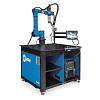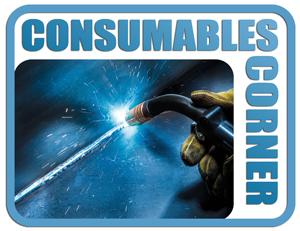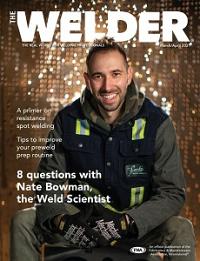Technical Liaison Manager
- FMA
- The Fabricator
- FABTECH
- Canadian Metalworking
Categories
- Additive Manufacturing
- Aluminum Welding
- Arc Welding
- Assembly and Joining
- Automation and Robotics
- Bending and Forming
- Consumables
- Cutting and Weld Prep
- Electric Vehicles
- En Español
- Finishing
- Hydroforming
- Laser Cutting
- Laser Welding
- Machining
- Manufacturing Software
- Materials Handling
- Metals/Materials
- Oxyfuel Cutting
- Plasma Cutting
- Power Tools
- Punching and Other Holemaking
- Roll Forming
- Safety
- Sawing
- Shearing
- Shop Management
- Testing and Measuring
- Tube and Pipe Fabrication
- Tube and Pipe Production
- Waterjet Cutting
Industry Directory
Webcasts
Podcasts
FAB 40
Advertise
Subscribe
Account Login
Search
Consumables Corner: Is it OK to have magnetic welds on a nonmagnetic surface?
- By David Meyer and Rob Koltz
- April 14, 2021
- Article
- Consumables

Rob Koltz and Dave Meyer discuss the ferritic (magnetic) and austenitic (nonmagnetic) features of welding stainless steel. Getty Images
Q: I am welding a tank made of 316 stainless steel, which is nonmagnetic. I’ve started welding the tank using ER316L wire and found that the welds are magnetic. Did I do something wrong?
A: You probably don’t have anything to worry about. It is normal for welds made with ER316L to attract a magnet, and it’s common for rolled 316 sheet and plate not to attract a magnet.
Depending on temperature and alloying level, iron alloys exist in several different phases, meaning the atoms in the metal are aligned differently. The two most common phases are austenite and ferrite. Austenite is nonmagnetic and ferrite is magnetic.
In ordinary carbon steels, austenite is a phase that exists only at high temperatures, and as the steel cools, the austenite transforms to ferrite. So, at room temperature, carbon steels are magnetic.
Several grades of stainless steel, including 304 and 316, are called austenitic stainless steels because their primary phase is austenite at room temperature. These stainless steels solidify as ferrite and transform to austenite as they cool. Austenitic stainless steel plate and sheet undergo controlled cooling and rolling operations that generally ensure that all ferrite has been transformed to austenite.
In the mid-20th century it was discovered that some ferrite present in the weld metal when welding austenitic stainless steels prevents microfissuring (cracking) that can occur if the filler metal is fully austenitic. To prevent microfissuring, most filler metals for austenitic stainless steel are designed to contain ferrite content of between 3% and 20%, so they will attract a magnet. In fact, the gauges used to measure how much ferrite is in a stainless steel weld also measure the level of magnetic attraction.
There are a few applications of 316 where it is crucial to minimize the magnetism of the welds, but this is rarely a requirement in a tank. I expect you are fine to continue welding without any worries.
About the Authors


Rob Koltz
Application Engineer
411 S. Ebenezer Rd.
Florence, 29501
636-485-2253
About the Publication
Related Companies
subscribe now

The Welder, formerly known as Practical Welding Today, is a showcase of the real people who make the products we use and work with every day. This magazine has served the welding community in North America well for more than 20 years.
start your free subscription- Stay connected from anywhere

Easily access valuable industry resources now with full access to the digital edition of The Fabricator.

Easily access valuable industry resources now with full access to the digital edition of The Welder.

Easily access valuable industry resources now with full access to the digital edition of The Tube and Pipe Journal.
- Podcasting
- Podcast:
- The Fabricator Podcast
- Published:
- 04/30/2024
- Running Time:
- 53:00
Seth Feldman of Iowa-based Wertzbaugher Services joins The Fabricator Podcast to offer his take as a Gen Zer...
- Trending Articles
Aluminum MIG wires offer smooth feeding, reduced tangling

The role of flux in submerged arc welding performance

Three ESAB welding machines win Red Dot Awards for product design

Power source added to cobot welding system for simplified automation

Connecticut students compete in Maritime Welding Competition

- Industry Events
Pipe and Tube Conference
- May 21 - 22, 2024
- Omaha, NE
World-Class Roll Forming Workshop
- June 5 - 6, 2024
- Louisville, KY
Advanced Laser Application Workshop
- June 25 - 27, 2024
- Novi, MI
Precision Press Brake Certificate Course
- July 31 - August 1, 2024
- Elgin,



























